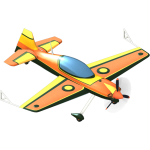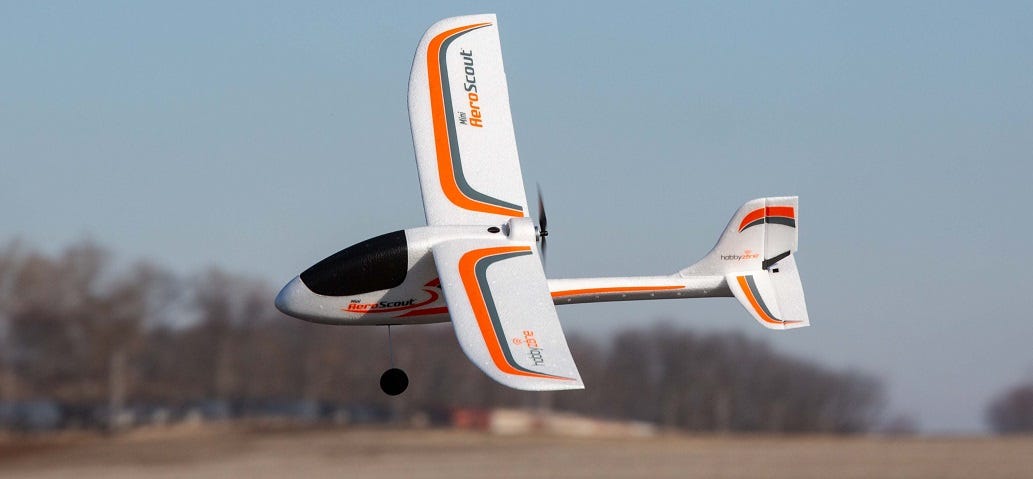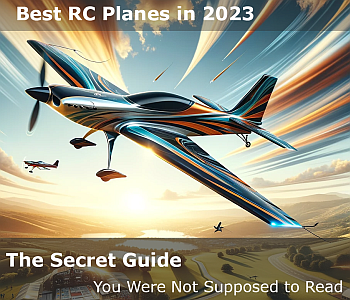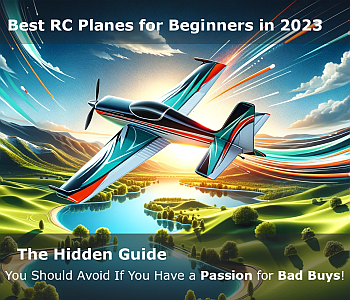Learning to Fly RC Planes – Lesson 10: Silver Wings
Prerequisites: You’ve taken your first couple of flights with your new aileron plane. You’ve done plenty of practice on the simulator.
Objectives: Not much really, I’m just going to chat about some stuff I think that maybe you need to know.
If you’ve got this far then congratulations. If your aileron plane is flying safely, and your rolling landings are successful then you have basically completed the objectives of this course. What I might try and do is talk about a whole host of tidbits of information that you might find useful in the rest of your model aviation pursuit.
Time for a New Type of Plane
Contents
When are you ready for your next type of plane? It’s a difficult question and it can come up for lots of reasons. Sometimes a model is smashed beyond repair and decide to replace it with something different, maybe you have become bored with the flying envelope of a model and want to try something else, or even you are convinced a model is not a good flyer and feel a different model would give you a better chance of mastering model flying.
- Only you can tell when you are ready for a new type of model, but the people you fly with (if there are any) can tell when you are not ready for a new model. Ask the ones you respect for their opinion.
- If your old model never flew well be honest with yourself and make sure it wasn’t because you chose a model too advanced for you.
- Before you move on it is best to have competence with your aileron trainer. After that, you can set your own pace (well you can now as well I suppose).
- When you look at a new model be realistic about whether you are ready for it yet. Push yourself a little perhaps, but don’t push yourself too much.
There are all sorts of possibilities that open up to you after you have taken the time to learn to fly your aileron trainer well – scale flying, aerobatics, and pattern, 3D, high speed, or just tooling around the park enjoying the sheer pleasure of any sort of RC flight. The best of luck to you with the next model after this one (and the one after that [and the one after that]).
Flying in Adverse Conditions
Unfortunately not every day is a perfect flying day (today for example, as I write this rather than flying). When is it good enough to go out, and when is it not? As usual, no definitives answers from me (handy isn’t it).
Try more and more adverse conditions at a pace that you are happy with and don’t risk your most breakable models in weather you haven’t flown in.
Here are a few tips:
- A strong steady breeze is quite manageable generally, but a gusty breeze can make flying risky.
- Keep your model upwind if flying in a strong breeze.
- Avoid parts of the field where the wind goes around/over/through significant obstacles (like a row of trees) – you often get wind sheer, eddies and other air disturbances in these areas.
- Make sure you land well before your battery is depleted. Having control authority and power is critical to staying safe.
- Make sure the model is appropriate. Models with very light wing loading (like Slow Stick, Pico Stick) and to a lesser extent models with very high drag (like Tigermoth) are not appropriate for adverse weather. Models which aren’t well powered and capable of flying faster than the wind speed are also out.
Confidence Versus Ability
If you have learned how to drive, and that was a few years ago now then you may have experienced the effect where your confidence increased faster than your abilities. Looking back you may realize that some of the “incidents” you found yourself in you survived more through good luck than good management (although at the time you may well have chalked it up to good management, further increasing unjustified confidence).
The same thing can happen with RC flying (fortunately, overconfidence in the air normally just results in a bruised ego and thinning wallet). If you fly, and nothing goes wrong, your confidence is naturally going to increase. If however, you have a few problems along the way, chances are that you are going to have somewhat adjusted your confidence to your ability.
Overconfidence in RC flying normally, in my experience, results in:
- Pilots flying too close to the ground.
- Attempting aerobatics too close to the ground.
- Trying to fly models that are well beyond their ability.
- Not bothering with checks (control throws are the right deflection and direction, radio checks etc)
I had a situation just like this myself the other day. I rolled a plane I was maidening on its back for inverted, even though this was its first flight, from only 10 meters up. I didn’t have enough elevator authority or time to roll her back, and she went in.
Now, there’s no soapbox here. I’ve skipped checks myself, and it didn’t cause me a problem, but then I’ve had crashes that if I’d done my normal checks I would have avoided, and had situations I would have recovered from if I followed my own rules (like the plane going in above – 10 meters, on a plane I didn’t know the flight envelope of – what was I thinking).
So, as you go forward, be aware of the difference between your confidence level and your ability.
Landings
Every landing involves two things that demand your attention:
- Your aircraft’s altitude goes from a safe flying one to ground level.
- Your aircraft’s velocity goes from one that enables flight, to zero.
A good landing is one where the rate at which altitude and velocity change is such that the aircraft is undamaged by the transition.
Sounds like gobbeldy gook – perhaps, but the point is that the difference between a good landing and a broken model is not that much.
For the reasons above landings are always somewhat risky, and unless you are super gifted they deserve your respect and full attention, and will for some time (probably forever). Tell the people talking to you to shut up (nicely! – or just block them out if you can) so that you can focus on the job at hand (unless of course the person talking to you is giving you landing instruction – with your permission – otherwise really tell them to shut up 8-).
Once you’ve got the basics of flying your aileron plane sorted, start to get lots of practice landing it. You can easily do 3 or 4 landings on every battery and still have some juice for fun, and the focused practice on landing will turn these moments of terror into times that you know are risky, but very doable provided you focus.
One more thing, as you get used to power approaches and landings don’t forget your dead stick landings because one day it will happen for you. On powered approaches, you control the rate of descent with the throttle. On dead stick approaches, you dive below the glide angle so you have enough airspeed to flare.
Interference, Mistakes and Other Flying Incidents
You do this hobby sooner or later you are going to have a crash. If you taught yourself to fly then chances are you’ve already had a few, but as you move onto different models the effects of crashes will almost certainly be worse. Trainers are tough and don’t tend to go in at full tilt because of their self-correcting nature.
There are many things that can start the path towards a crash, but one thing is consistent – a crash ends with an aircraft striking an object or the ground. Hence, if you can stay away from objects (including the flying kind) your chances of a glitch, temporary loss of orientation, wind gust, solar flare, flameout, collision etc taking out your model are reduced.
Now contrary to what has been suggested through the course, this relationship with the ground and altitude is not fixed. For lots of reasons (see below) being close to the ground becomes riskier as you get further and further away. The diagram at the right attempts to illustrate this (and yes I did think long and hard before labeling the area close to the ground the “Danger Zone” for fear it would send Top Gun fans flying straight for it).
As your model gets further away from you:
- It is more likely to take an interference hit.
- It is harder to see leading to a more likely loss or orientation. This applies to depth perception as well – once your model is far enough away it is really hard to tell if it is in front of, or behind that tree/light pole.
- It will be harder to land if you suffer a power failure.
The odds of surviving each of these situations will be improved if you have altitude (or clearance in the case of an obstacle like a tree or light post). Altitude gives you time to recover from a loss of orientation or glitch, and if you lose power, you have a chance to get the model somewhere back close to you to land.
Now, I don’t know if the numbers I’ve given in the diagram are entirely accurate. Maybe you can go out to 100 meters before you need 15 meters of altitude, but the idea is that the safe area to fly your model is cone-shaped, and it gets higher as you get further away. Can you fly below it – of course, you can, but you are increasing the risk of an incident taking out your plane.
Having lost power at 100 meters with only 5 meters of altitude, on a small park flyer, my experience is that the fate of your model is in the hands of the gods because you can’t see well enough to do anything particularly meaningful.
Flying Attitude
As I’ve written these pieces I have the awful feeling that I’ve probably come on a bit strong with the fire and brimstone stuff. I’ve tried to never say though shalt not, although I’m sure that meaning could often be inferred from my words.
Allan Kirk, from NZ Motor Cycle Safety Consultants, in relation to motorcycling (another past time of mine) about the idea of a child and an adult riding a motorcycle.
The child is adventurous, enthusiastic, passionate, curious and brash, while the adult is cautious, pragmatic, rationale and reserved. The key to enjoying what you are doing, but doing it safely is being able to be the child when the conditions are right, but being able to switch back to the adult immediately when you have to. In many ways, I think it is a great way to think about RC flying.
At the end of the day, my opinion is that the only absolute duty you owe in your flying is to take reasonable steps to ensure you don’t harm others or their property. This is the time that you must be the adult. The rest of the time, you are probably going to take some risks to learn and to enjoy yourself. As long as the only thing you are risking is your aircraft (and ego and wallet) you can leave the child in charge as long as you wish. But, as soon as the prospect of actual harm to others, or their property is present then you need to let the adult take over. There is also nothing wrong with letting the adult set limits that the child is allowed to play within – you can do anything you like above 10 meters, you can fly upside down at any altitude as long as it is in that area, etc.
The only other things I want to mention are persistence and resilience. You will suffer some setbacks. While you are still enjoying it keep at it. Let the adult figure out what went wrong, and set new boundaries for the child, until they can be relaxed again.
Conclusion
This is the last of the course. Congratulations on coming this far. I wish you all the best for your model aviation future.




